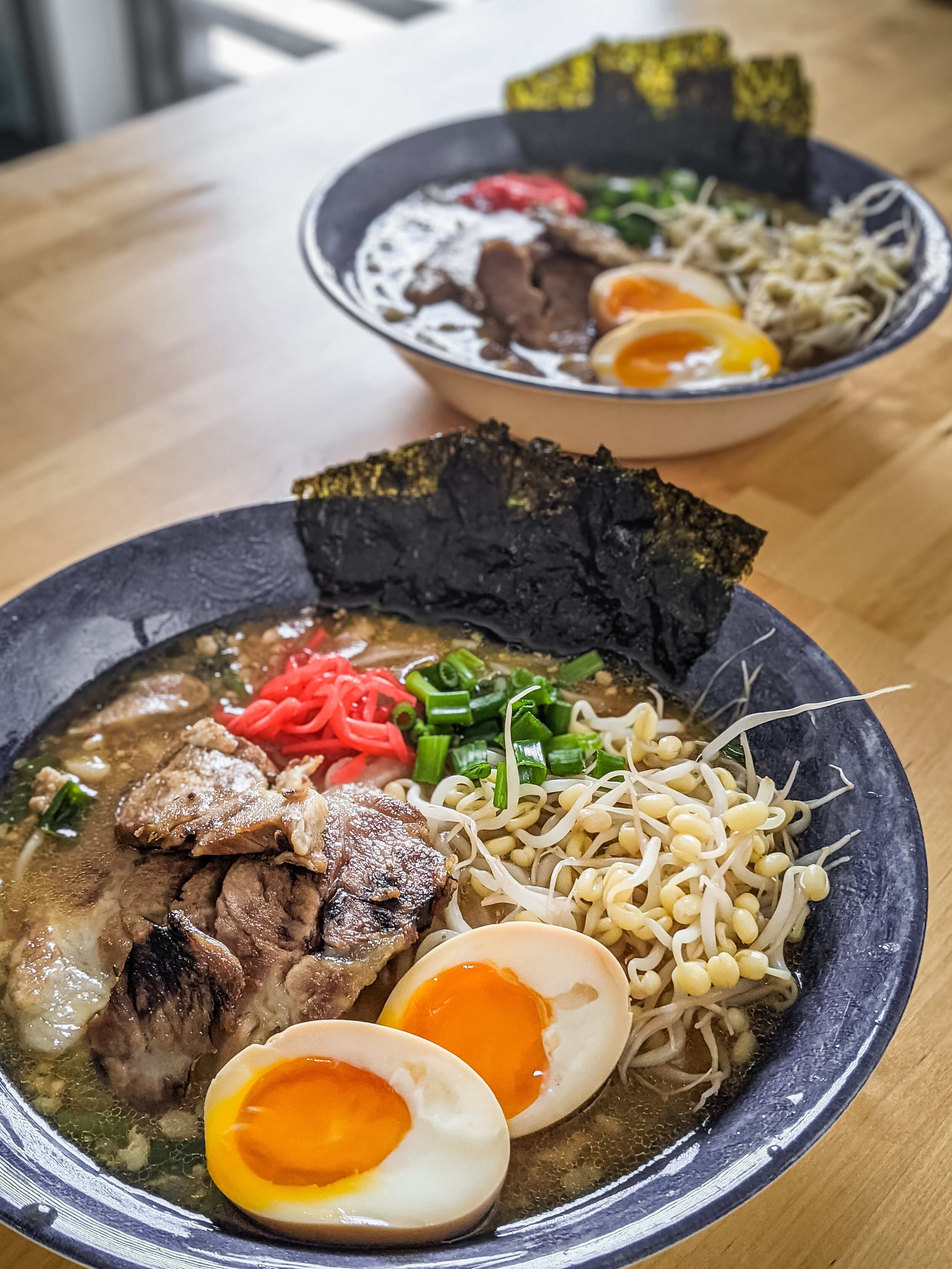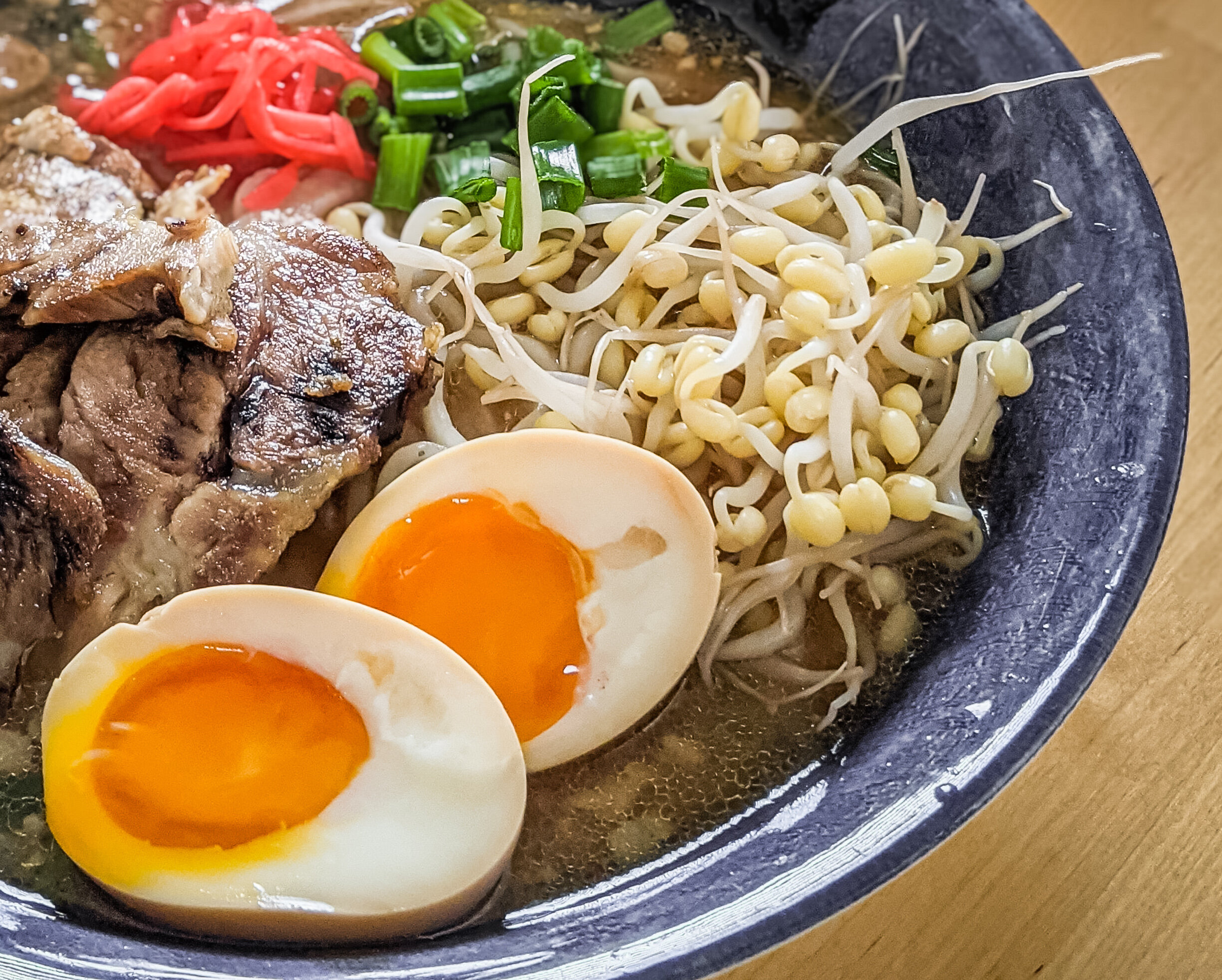Ramen Homemade: a recipe from Japan

If it wasn’t clear from the recipes I posted on the blog and on Instagram, I love Japanese food. It has been love at first bite since the first time I visited Japan.
Disclaimer: I didn’t love Japanese food the first time ever. Maybe because it was a piece of sushi in Egypt. Weird combination, I know. But I couldn’t help falling in love with it when I tried the real Japanese Food.
Coming back to authentic food from Japan, there are many things that I love:
their rich tradition,
the respect for seasonality,
the incredible variety of ingredients, and cooking techniques,
the incredible range from homemade comfort food to fine dining and exclusive ingredients.
I simply find its richness fascinating, and Japanese restaurants around the world can only represent a small part of the variety. You have to visit Japan.
Anyway, after this love declaration, I have to admit that I occasionally decided to eat gluten during my visit, I wanted to understand the local flavours without barriers (ramen, noodles, delicacies on the grill, local sweets and so on) but I promised myself that I would try to re-create those flavours in a gluten-free solution as soon as I could.
I already posted my recipes for:
Okonomiyaki (the delicious cabbage pancake typical from Osaka)
Onigiri ( the traditional rice ball wrapped in a strip of dry seaweed, visible in many Japanese anime)
Dorayaki (the sweet delicious and fluffy pancake filled with sweet redbean paste, you might recognize it if you watched Doraemon)
There are more japanese dishes that I cook at home, and I’ve been practising also in order to share with you.
One of the most important dish, and challenging one, is Ramen.
Varieties of Ramen
There are so many varieties that I didn’t know where to start my experiments, but with some guidance from the book “Japanese Soul Cooking”, cooking classes in Japan and online research, I have to say that I’m really happy with the result.
In the book you can find 7 ramen recipes, including some of the most popular versions present in Japan like :
Shoyu Ramen - with a base of Soy Sauce
Miso Ramen - with miso paste and minced pork
Shio Ramen - with sea salt, from the North of Japan
Sure, if you live close to a ramen bar (my favourite ones and in Japan and surprisingly in Amsterdam) and you are not gluten intolerant you don’t need to go through the hustle of preparing it yourself. But believe me, the result is so good that you will not be disappointed in any case.
If you are ok to eat gluten feel free to buy ramen noodles in a shop or online. If gluten is out of the picture for you, then you can use one of my recipes:
homemade pasta recipe (a bit easier to do, but not properly japanese)
the ramen noodles recipe below (the one I learned in Japan, turned gluten-free.
Here we go, without further ado, this is my adapted version of the Miso Ramen (my personal favourite).
Ingredients for 2 people
For the broth:
500 gr chicken (better drumsticks or bones)
250 gr pork shoulder in 1 piece
1,6 liters of water
12 gr fresh ginger
1 garlic cloves
1 spring onion
1 small carrot
For the ramen eggs:
120 ml water
120 ml tamari or gluten-free soy sauce
60 ml sake
30 ml mirin
20 gr fresh ginger
1 garlic cloves
1 spring onion
2 eggs
For the miso ramen:
4 tbsp miso
30 ml sake
2 tbsp mirin
5 gr grated ginger
1 small tsp tobanjan (optional, if you can find it gluten-free)
2 tbsp sesame oil
100 gr ground pork
150 gr cabbage
150-200 gr ramen or fresh noodles (recipe 1, recipe 2 or buy gf noodles)
For garnishing:
100 gr bean sprouts
4 slices of cooked pork shoulder (you can use the pork shoulder from the broth)
3-4 tbsp chopped spring onion
2 marinated ramen eggs (ingredients above, better to prepare them the say before)
Optional: Seaweed, sesame seeds, pickled ginger, japanese sesame oil, and japanese spices to taste
Making Ramen
Part 1 The broth (better the day before)
Boil together in a pan the following: 1.6 liters of water, the chicken and pork, the ginger and garlic previously crushed, carrot and spring onion.
Boil for 2 hours, then remove the pork and preserve separately in a container.
Strain the broth and preserve it in a container.
Part 2 The soy sauce marinade & ramen eggs (for sure the day before)
Note - this part can be optional for the Miso Ramen, but the eggs are one of my favourite parts, so I never skip it.
Place all the ingredients in a mid-size sauce pan: water, tameri, sake, mirin, the garlic (peeled and crushed), the chopped spring onion, the ginger (crushed).
Heat up until it boils and then let it rest until it goes back to room temperature.
In the meantime boil the eggs: add them to already boiling water and cook for 5-8 minutes. 5 is for runny eggs, 8 is max for softer but cooked eggs.
Let the eggs cool down in cold water.
Place the peeled eggs in the marinade for at least 12 hours. Better if it’s in a closed container, either a bowl with a cover or even a zip bag. Better to make sure that the marinade covers the eggs entirely.
Part 3 Preparing your homemade ramen bowl (it’s got to be hot-hot-hot)
Start your preparation of the core miso flavour by adding the sake, mirin, garlic and ginger to a small pan. Combine well the miso to the mix and remove from the heat. Add the tobanjan now if you decide to use it.
Heat up the sesame oil in a pan and add the pork together with the spring onion. Cook briefly and then add the shredded cabbage. Cook for a couple of minutes and then add the ramen soup until it’s hot. Last add the miso paste you just prepared and make sure everything is well combined. Let it boil for a minute or so.
Briefly grill 2 portions of sliced pork shoulder in a hot pan.
In the meantime cook the noodles separately and also boil the bean sprouts for a couple of minutes in another pan with water.
At this point you’re ready to combine your delicious flavourful bowl of homemade ramen. Pour ½ of the ramen soup in each bowl (make sure it’s boiling hot when you serve), add ½ of the noodles and then the other toppings: pork shoulder, 1 marinated egg divided into 2 halves, ½ of the bean sprouts and other toppings to your taste.
Making Ramen Noodles Gluten Free
Ingredients for 3-4 servings:
First of all blend this mix: 90 gr corn starch, 90 gr potato starch, 30 gr rice flour, 10 gr xanthan gum
2 tbsp baking soda
1 tsp salt
150 ml hot water
Follow these simple steps:
Cook the baking soda in a little pan over low-medium heat for 10 minutes. Mix repeatedly.
Add the baking soda to the water, together with the salt.
Prepare the dough by adding the liquid solution to the flour little by little. If the dough is too dry add a tbsp of water and work with your hands. Tip: work with half dough at a time to make it more manageable. The result should be an homogeneos ball of dough, elastic enough to flatten and shape into pasta.
Create the noodles by flattening and cutting with a pasta maker or with a rolling pin and rolling cutter.
Cooking the noodles: best is to cook the noodles in boiling water for at least 5 minutes. Taste after this time. The cooking time actually depends on the thickness.
Usually it’s advisable to drain and wash with cold water before adding the noodles to the ramen soup.
Tricks to save on time
Do the broth and ramen eggs 2-3 days before, it will be less tiring
Make double quantities. You can freeze the broth (for up to 2 weeks) and keep the marinated eggs in the refrigerator for up to 1 week. If you use packed noodles that’s great, if you made your own you can double the quantities and freeze half the noodles.




